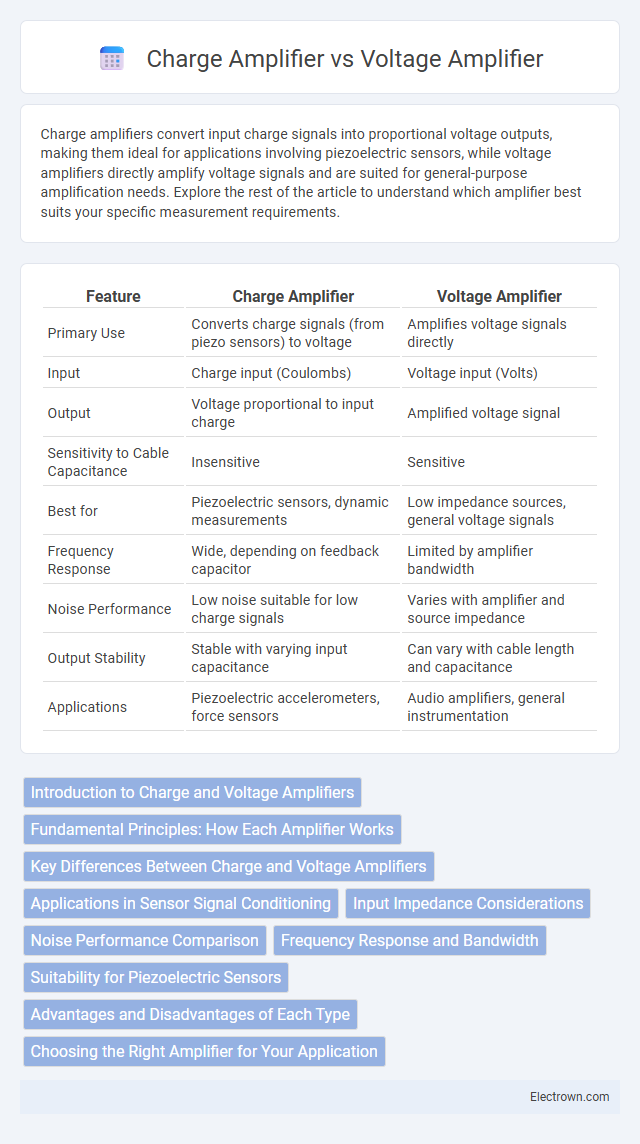Charge amplifiers convert input charge signals into proportional voltage outputs, making them ideal for applications involving piezoelectric sensors, while voltage amplifiers directly amplify voltage signals and are suited for general-purpose amplification needs. Explore the rest of the article to understand which amplifier best suits your specific measurement requirements.
Table of Comparison
| Feature | Charge Amplifier | Voltage Amplifier |
|---|---|---|
| Primary Use | Converts charge signals (from piezo sensors) to voltage | Amplifies voltage signals directly |
| Input | Charge input (Coulombs) | Voltage input (Volts) |
| Output | Voltage proportional to input charge | Amplified voltage signal |
| Sensitivity to Cable Capacitance | Insensitive | Sensitive |
| Best for | Piezoelectric sensors, dynamic measurements | Low impedance sources, general voltage signals |
| Frequency Response | Wide, depending on feedback capacitor | Limited by amplifier bandwidth |
| Noise Performance | Low noise suitable for low charge signals | Varies with amplifier and source impedance |
| Output Stability | Stable with varying input capacitance | Can vary with cable length and capacitance |
| Applications | Piezoelectric accelerometers, force sensors | Audio amplifiers, general instrumentation |
Introduction to Charge and Voltage Amplifiers
Charge amplifiers convert input charge signals into proportional voltage outputs, making them essential for measuring sensors like piezoelectric devices that generate charge. Voltage amplifiers increase the amplitude of voltage signals directly, suitable for applications requiring signal boosting without altering charge characteristics. Understanding the distinction helps you select the appropriate amplifier for precise sensor signal conditioning in various electronic systems.
Fundamental Principles: How Each Amplifier Works
Charge amplifiers convert input charge from sensors into a proportional voltage signal by integrating the current, making them ideal for piezoelectric sensors that generate charge. Voltage amplifiers amplify the input voltage signal directly without integration, responding to voltage changes across the sensor terminals. Your choice depends on the sensor type and application, as charge amplifiers provide stable, low-noise outputs for high-impedance sources, whereas voltage amplifiers are suited for low-impedance, voltage-output devices.
Key Differences Between Charge and Voltage Amplifiers
Charge amplifiers convert input charge into a proportional voltage output, making them ideal for piezoelectric sensor applications, whereas voltage amplifiers directly amplify the input voltage signal. The key differences include input impedance, with charge amplifiers having high input impedance to accurately measure charge without signal loss, while voltage amplifiers have lower input impedance suited for voltage signals. Your choice depends on the sensor type and signal conditioning requirements, as charge amplifiers handle high-frequency, low-level charge signals better, and voltage amplifiers are optimal for standard voltage signal amplification.
Applications in Sensor Signal Conditioning
Charge amplifiers are ideal for applications involving piezoelectric sensors, converting high-impedance charge signals into usable voltage outputs, essential for precise vibration and pressure measurements. Voltage amplifiers suit resistive and capacitive sensors, providing stable voltage gains for signals with lower impedance levels, often used in temperature and strain gauge sensors. Selecting Your amplifier depends on sensor type and signal integrity requirements, ensuring optimal signal conditioning performance.
Input Impedance Considerations
Charge amplifiers feature high input impedance, making them ideal for use with piezoelectric sensors that generate low-level charges, as they minimize signal loss and distortion. Voltage amplifiers generally have lower input impedance, which can load the sensor and degrade signal integrity, especially when connected to high-impedance sources. Understanding your sensor's characteristics and the amplifier's input impedance is crucial to ensure accurate signal acquisition and optimal measurement performance.
Noise Performance Comparison
Charge amplifiers exhibit superior noise performance compared to voltage amplifiers when measuring capacitive sensors, as they directly convert sensor charge into output voltage, minimizing noise intrusion. Voltage amplifiers tend to amplify both signal and noise equally, resulting in a lower signal-to-noise ratio, especially in high-impedance sensor applications. The intrinsic low input impedance and feedback mechanism of charge amplifiers effectively reduce noise susceptibility, making them ideal for precision, low-noise measurements in piezoelectric sensor systems.
Frequency Response and Bandwidth
Charge amplifiers offer a flat frequency response over a wide range, making them ideal for measuring high-frequency signals from piezoelectric sensors with minimal signal distortion. Voltage amplifiers can suffer from reduced bandwidth and frequency response limitations due to input capacitance and sensor bias requirements, potentially compromising signal integrity at higher frequencies. Your choice depends on the application, where charge amplifiers excel in high-frequency environments and voltage amplifiers are suitable for low-frequency or steady-state measurements.
Suitability for Piezoelectric Sensors
Charge amplifiers are highly suitable for piezoelectric sensors due to their ability to convert the sensor's high-impedance charge output into a low-impedance voltage signal, preserving accuracy and sensitivity in dynamic measurements. Voltage amplifiers are less ideal for piezoelectric applications because they directly amplify the sensor's voltage, which can be affected by cable capacitance and leakage currents, leading to signal distortion. Your choice should favor charge amplifiers to ensure reliable and precise signal conditioning for piezoelectric sensor outputs.
Advantages and Disadvantages of Each Type
Charge amplifiers excel in measuring signals from piezoelectric sensors by providing high input impedance and minimizing signal loss, but they often require careful shielding and grounding to avoid noise interference. Voltage amplifiers offer simpler design and direct voltage measurement, making them suitable for general-purpose applications, though they may introduce loading effects on sensors and lack the high-frequency response of charge amplifiers. Selecting between the two depends on specific application needs, such as sensor type, signal integrity, and environmental noise conditions.
Choosing the Right Amplifier for Your Application
Selecting the right amplifier depends on the sensor type and signal characteristics; charge amplifiers are ideal for piezoelectric sensors requiring high input impedance and low noise to accurately capture dynamic charge signals. Voltage amplifiers suit resistive sensors and applications with stable DC signals, providing straightforward voltage scaling and less sensitivity to cable capacitance. Understanding the sensor output and application requirements ensures optimized signal integrity and measurement accuracy.
charge amplifier vs voltage amplifier Infographic

 electrown.com
electrown.com